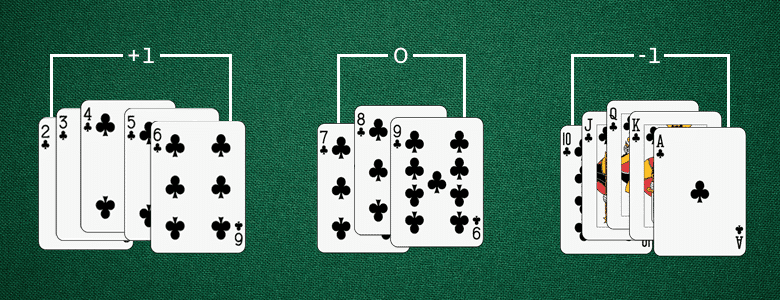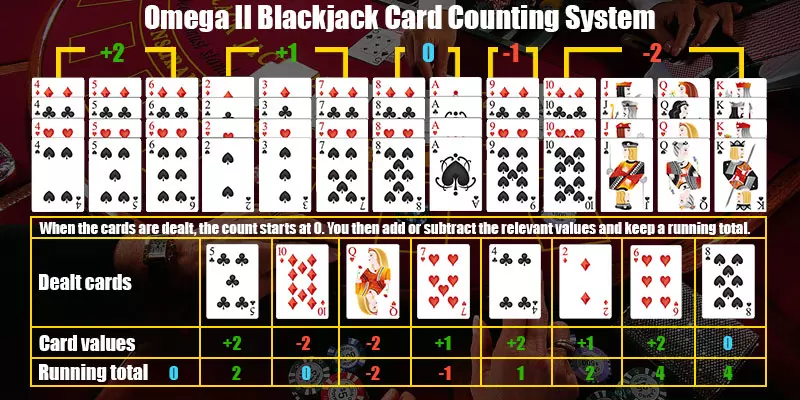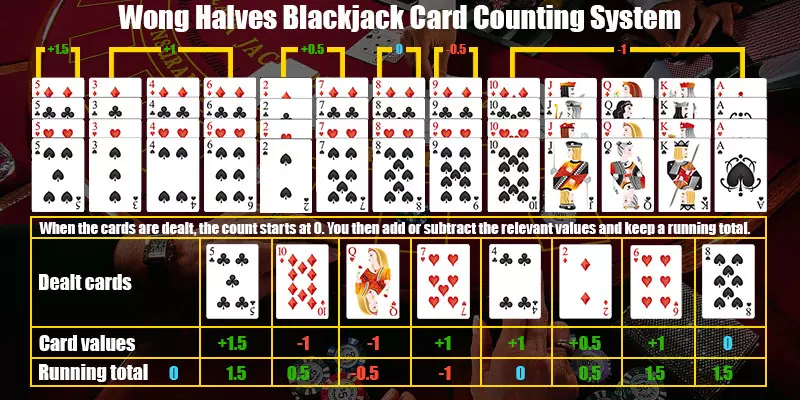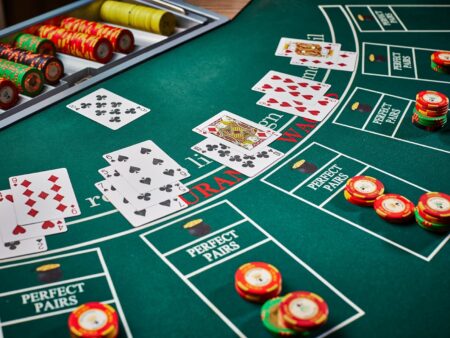Card counting is a popular skill amongst experienced blackjack players, allowing them to improve their odds of winning by keeping track of which cards have already been played in the game.
A Beginner’s Guide: How to Count Cards in Blackjack
Table of Contents
- 1 How to Count Cards in Blackjack: A Beginner’s Guide
- 2 Introduction
- 3 What is Card Counting in Blackjack?
- 4 How Does Card Counting Work?
- 5 Basic Blackjack Card Counting Strategy
- 6 Advanced Blackjack Card Counting Strategies
- 7 Live Online Blackjack Card Counting
- 8 Blackjack Card Counting Apps
- 9 Learn Basic Blackjack Strategy
- 10 Understand Basic Blackjack Rules
- 11 Is Counting Cards Illegal?
- 12 Blackjack Card Counting Myths
- 13 Conclusion
- 14 Frequently Asked Questions
- 14.1 Can you make a living counting cards in blackjack?
- 14.2 When should I bet when counting cards?
- 14.3 Can you win blackjack without counting cards?
- 14.4 Is it difficult learning to count cards in blackjack?
- 14.5 Why Does Card Counting Work?
- 14.6 What’s the History of Card Counting?
- 14.7 Should I Become a Card Counter?
How to Count Cards in Blackjack: A Beginner’s Guide
Introduction
Card counting is a popular skill amongst experienced blackjack players, allowing them to improve their odds of winning by keeping track of which cards have already been played in the game. It’s not an easy skill to master and requires practice and dedication, but with enough effort and time it can be done. This guide will provide a basic overview of card counting, explaining what it is as well as strategies for learning and increasing your ability to count cards effectively.
What is Card Counting in Blackjack?
Card counting is the process of keeping track of which cards have been played in a game of blackjack in order to gain an advantage over other players or the house. This involves assigning each card in the deck its own numerical value, from -1 to +1, depending on how favorable it is for the player. The idea behind this system is that when more high-value cards are still in the deck, the player has a greater chance of winning as those cards tend to favor them. Conversely, when there are more low-value cards in the deck, it’s not beneficial for the player and can be used to their disadvantage.
To keep track of which card values have been played in a game of blackjack, card counters assign each card its own value from -1 to +1 and then add or subtract them up per hand. For example, if an Ace was already played it would be given a value of -1 while a nine would be given a value of +1. A running count is then kept, with the player using this information to determine when it’s in their favor to make a bet or not.
How Does Card Counting Work?
In order to be successful at card counting in blackjack, players must first understand how the game works and become familiar with basic strategy. Players should also develop an understanding of the house edge and how it affects their chances of winning or losing over time. Once they are comfortable with these concepts, they can move on to learning the process of card counting itself.
- The first step to learning card counting is memorizing which cards receive what values from -1 to +1 (ace being -1, two being +1 etc.). Then, players must become adept at quickly calculating the running count as each card is dealt. This involves adding or subtracting the values of each card and keeping a mental tally of the running count throughout each hand.
- The next step to mastering card counting is learning how to adjust your betting according to the running count. Generally, when the count is positive (there are more high-value cards in the deck) it’s beneficial for you to bet higher amounts, while when it’s negative (there are more low-value cards in the deck) it’s better to lower your bets or even abstain from making one altogether.
- Finally, players need to understand that although card counting can give them an edge in blackjack, it is not a guaranteed win and requires practice and dedication to be successful. Additionally, casinos are aware of card counting strategies and have measures in place to detect players who are suspected of using this skill.
Basic Blackjack Card Counting Strategy
Although card counting can be a complicated skill, there are some basic strategies that beginners can start to use as they learn.

How to Count Cards in Blackjack with the Hi-Lo System
One of the most popular card counting systems is known as the Hi-Lo system. This involves assigning each card in a deck its own numerical value, from -1 to +1, with higher-value cards (such as Aces and 10s) receiving a value of -1 while lower-value cards receive a value of +1. Players then add or subtract these values per hand and keep track of the running count throughout the game.
The Hi-Lo system is suitable for beginners as it’s quite easy to learn and can be applied to multiple decks of cards at once. Additionally, this system takes into account factors such as how favorable certain cards are for the player versus how unfavorable they are for the house, making it a helpful tool for new card counters.
What is ‘True Count’ in Blackjack? How Does it Affect Card Counting?
Another important concept that inexperienced card counters need to understand is true count. This is the running count of a game adjusted for the number of decks currently in play. Generally, players should use true count when they’re playing with multiple decks as it’s more accurate than just using the raw running count. By adjusting their betting according to the true count, players can gain an even bigger edge over the house and increase their chances of winning in blackjack. Additionally, experienced card counters may use true count information to make decisions about whether or not to split pairs or double down on certain hands.
How Much Should I Bet When Counting Cards?
When it comes to betting when card counting, players should adjust the amount of their wagers depending on the running count. Generally, if the running count is negative then your chances of winning are lower and you should reduce your bets accordingly. Conversely, if the running count is positive your chances of winning are higher so you can bet more confidently in these situations.
Furthermore, experienced card counters may also use ‘betting spread’ as a way to make even bigger profits. Betting spread involves increasing your bets dramatically when the count favors you and dropping them significantly when it doesn’t. This strategy enables more aggressive bettors to maximize their winnings when they have an advantage over the house but also minimizes losses during unfavorable rounds.
How to Count Cards with 1 Deck
Although most blackjack games are played with multiple decks, some casinos offer single-deck variations. Card counting when playing with just one deck is slightly different to the Hi-Lo system as there are fewer low cards (2s, 3s and 4s) in the deck. As a result, players should assign each card in the deck its own value from -2 to +2 rather than -1 to +1.
Additionally, card counters playing single-deck blackjack games must pay close attention to how many cards have already been dealt during any given round. This is important because as more cards are removed from the deck it becomes easier for players to keep track of what’s left in it and adjust their bets accordingly.
How to Count Cards with Multiple Decks
When playing blackjack with multiple decks, it’s important to understand that players should use the Hi-Lo system rather than assigning each card its own value of -2 to +2. Additionally, card counters must pay close attention to the true count at all times and adjust their bets according to changes in the running count. This is because multiple deck games can be quite unpredictable as more cards are dealt throughout any given round.
Tips for Mastering Card Counting
Becoming a successful card counter takes time and practice. Here are some tips that beginners should keep in mind when learning to count cards:
- Start by practicing with a single deck of cards before moving on to multiple decks.
- Always adjust your bets according to the true count and never rely solely on the raw running count.
- Pay close attention to how many cards have already been dealt during each round as this will help you to accurately assess the remaining deck composition.
- Don’t be afraid to use betting spread even if it feels intimidating at first – this strategy can maximize your winnings significantly when used correctly.
Advanced Blackjack Card Counting Strategies

How to Count Cards Using the Omega II System
The Omega II system is a popular card counting technique that was developed in the 1970s. It works by assigning each card in the deck with a value from +2 to -2, which is similar to how card counters play single-deck blackjack. However, it’s important to note that this system does not track individual cards but rather assigns values based on their frequency in the deck.
For instance, low cards (2s, 3s and 4s) are counted as +1 whereas middle and high cards (7s through Aces) are counted as -1. By tracking these frequencies throughout any given round of blackjack, players can gain an edge over the house and increase their chances of winning big.

How to Count Cards Using the Wong Halves System
The Wong Halves system is another popular technique used by experienced card counters. It assigns each card a value from -0.5 to +1, which makes it easier to calculate the running count and adjust your bets accordingly. This system also works best with multiple decks in play as it’s designed specifically for high card prevalence games such as blackjack and baccarat.
When using this particular counting system, players should pay close attention to how many cards have already been dealt throughout any given round. This is because the true count can fluctuate significantly depending on how many cards are left in the deck, making it important for players to adjust their bet sizes according to these changes.
Which Card Counting System is the Best for Blackjack?
The answer to this question really depends on the individual’s playing style and preferences as each card counting system has its own set of benefits and drawbacks. For instance, some players may prefer the Hi-Lo system due to its simplicity while others might opt for more advanced systems such as Omega II or Wong Halves in order to maximize their winnings.
Live Online Blackjack Card Counting
Live online blackjack can be a great way for players to improve their card counting skills since it allows them to practice in real-time with live dealers. Additionally, many online casinos offer incentives and bonuses for new players which makes it even more appealing. When playing live online blackjack, it’s important to remember that the house always has an edge no matter what strategies you use. Therefore, card counters should adjust their bets according to changes in the running count while keeping an eye on the true count at all times.
Blackjack Card Counting Apps
Using a card counting app can be an invaluable tool for anyone looking to become a successful card counter. These apps allow players to practice their card counting skills without risking any money, which is perfect for beginners. Additionally, most of these apps provide real-time feedback on your results and offer tips on how to improve your overall game strategy.
Learn Basic Blackjack Strategy
It’s important to understand basic blackjack strategy in order to maximize your winnings. This includes understanding when and how to hit, stand, split and double down as this can make a huge difference in the long run. Additionally, players should take some time to familiarize themselves with the house edge of each version they are playing in order to get an advantage over the casino.
Understand Basic Blackjack Rules
Knowing the basic rules of this card game is essential for any player looking to become a successful card counter. This includes understanding when and how to surrender, what type of bets are allowed, and if there are any special rules in play such as late surrender or doubling after splitting. Additionally, players should also be aware of table limits as this will affect their overall betting strategy.
Is Counting Cards Illegal?
No, counting cards is not illegal as it simply involves tracking a game’s changing probabilities. However, some casinos may consider card counting to be cheating and will ask players to leave if they are suspected of doing so. Additionally, the use of devices such as computers or calculators to aid in card counting is strictly prohibited in most casinos.
Blackjack Card Counting Myths
There are many myths surrounding card counting that have been circulating for years. One of the most common is that it’s impossible to count cards successfully in a single deck game. However, this is false as skilled players can often gain an advantage over the house when playing in these types of games. Additionally, there is also a widespread belief that card counters always win but this too is untrue as they may not always be successful in their endeavors.
Conclusion
In conclusion, card counting is a skill that takes time and dedication to master. It can be a great way to gain an advantage over the house but it also carries some risks. Players should take their time in learning basic blackjack strategy and rules before diving into the world of card counting. Additionally, they should also use available tools such as apps to practice and refine their skills. With enough perseverance, anyone can become a successful card counter!
Frequently Asked Questions
Can you make a living counting cards in blackjack?
It is possible to make a living counting cards in blackjack but it takes a great deal of discipline, practice, and dedication.
When should I bet when counting cards?
When counting cards, players should adjust their bets according to changes in the running count while keeping an eye on the true count at all times.
Can you win blackjack without counting cards?
Yes, it is possible to win blackjack without counting cards by using basic strategy and playing with a bankroll management system.
Is it difficult learning to count cards in blackjack?
Learning to count cards in blackjack can be challenging but it is possible with the right practice and dedication.
Why Does Card Counting Work?
Card counting works because it gives players an edge over the house by allowing them to predict how likely they are to get a winning hand.
What’s the History of Card Counting?
Card counting has been around since the early 1960s and was popularized by a group of students at the University of California, Berkeley.
Should I Become a Card Counter?
Whether or not to become a card counter is ultimately up to the individual. It is possible to make money from it but it is important to understand the risks and rewards of card counting before taking the plunge.


















